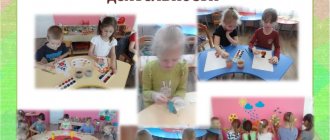SAMPLE DAILY ROUTINE FOR ALL AGE GROUPS
The kindergarten opens at 7.00.
Our day begins with free time, spent by the child of his own choice, playing and communicating with children and adults, working in various centers.
- Morning exercises allow you to organize children, invigorate them and set them up for the coming day. Breakfast. At 9.00, organized educational activities with children begin in all age groups, as well as individual lessons with a speech therapist, psychologist. A walk in the fresh air. Lunch. Daytime nap. Children can sleep, relax, listening to music or a fairy tale. Wake-up exercises. Hardening procedures, prevention of flat feet. Afternoon snack. Games, joint activities of children and teachers, individual and group classes with a psychologist, walk. Dinner.
The kindergarten closes at 19.00, at which time the paid working day of teachers ends. You can find out more detailed information about the organization of your baby’s life in this age group by studying the daily routine.
DAILY REGIME
Early age group
Cold season
Reception, examination, games 7.00-8.00 Morning exercises 8.00-8.10 Preparation for breakfast, breakfast 8.10-8.40 Games, preparation for classes 8.40-9.00 Organized educational activities 9.00-9.30 Preparation for a walk, walk (games, observations) 9.30-11.00 Return from a walk 11.00-11.15 Preparing for lunch, lunch 11.15-12.00 Preparing for bed, nap 12.00-15.00 Getting up 15.00-15.10 Preparing for afternoon snack, afternoon snack 15.10-15.20 Classes, games, independent activities 15. 20-15.45 Preparing for a walk, walk 15.45-16.55 Returning from a walk 16.55-17.10 Preparing for dinner, dinner 17.10-17.35 Games, children going home 17.35-19.00
2nd junior group
Cold season
Reception, examination, games 7.00-8.00 Morning exercises 8.00-8.10 Preparation for breakfast, breakfast 8.10-8.35 Independent games 8.35-9.00 Organized educational activities 9.00-9.40 Preparation for a walk, walk (games, observations) 9.40-11.25 Return from a walk 11.25-11.45 Preparing for lunch, lunch 11.45-12.30 Preparing for bed, nap 12.00-15.00 Getting up 15.00-15.10 Preparing for afternoon snack, afternoon snack 15.10-15.20 Activities, games 15.20-15.45 Preparing for a walk , walk 15.45-16.55 Returning from a walk 16.55-17.10 Preparing for dinner, dinner 17.10-17.45 Games, children going home 17.45-19.00
Middle group
Cold season
Reception, examination, games, duty 7.00-7.50 Morning exercises 7.50-8.00 Preparation for breakfast, breakfast 8.00-8.35 Independent games 8.35-9.00 Organized educational activities 9.00-9.50 Preparation for a walk, walk (games, observations) 9.40 -11.45 Return from a walk 11.45-12.00 Preparing for lunch, lunch 12.00-12.35 Preparing for bed, nap 12.35-15.00 Getting up 15.00-15.10 Preparing for afternoon snack, afternoon snack 15.10-15.20 Classes, games, independent activities 15.20 -16.05 Preparing for a walk, walk 16.05-17.05 Returning from a walk 17.05-17.20 Preparing for dinner, dinner 17.20-17.50 Games, children going home 17.50-19.00
Senior group
Cold season
Reception, examination, games, duty 7.00-8.10 Morning exercises 8.10-8.20 Preparation for breakfast, breakfast 8.20-9.00 Organized educational activities 9.00-10.15 Preparation for a walk, walk (games, observations, work) 10.15-12.00 Return from walks 12.00-12.10 Preparing for lunch, lunch 12.10-12.40 Preparing for bed, naps 12.40-15.00 Getting up 15.00-15.10 Preparing for afternoon tea, afternoon snack 15.10-15.20 Classes, games, independent activities 15.20-15.45 Preparing for walk, stroll 15.45-17.15 Returning from a walk 17.15-17.25 Preparing for dinner, dinner 17.25-17.50 Games, children going home 17.50-19.00
Preparatory group for school
Cold season
Reception, examination, games, duty 7.00-8.30 Morning exercises 8.30-8.40 Preparation for breakfast, breakfast 8.40-9.00 Organized educational activities 9.00-10.30 Preparation for a walk, walk (games, observations, work) 10.30-12.15 Return from walks 12.15-12.30 Preparing for lunch, lunch 12.30-13.00 Preparing for bed, naps 13.00-15.00 Getting up 15.00-15.10 Preparing for afternoon tea, afternoon snack 15.10-15.20 Classes, games, work, independent activities 15.20-15.50 Preparing for a walk, walk 15.50-17.20 Returning from a walk 17.20-17.30 Preparing for dinner, dinner 17.30-17.55 Games, children going home 17.55-19.00
Recommendations from teachers on the daily routine for preschoolers are here.
Daily regime
An indispensable condition for a healthy lifestyle and successful development of children is the correct regime. The correct daily routine is a rational duration and reasonable alternation of various types of activities and rest for children during the day. The main principle of correct construction of the regime is its compliance with the age-related psychophysiological characteristics of children.
The preschool educational institution uses a flexible daily routine; changes can be made to it based on the characteristics of the season, the individual characteristics of the children, and health status. The flexibility of the regime is also influenced by the surrounding society.
Daily schedule for early age groups:
Type of activity Time in daily routine Duration At home Getting up, hygiene procedures 630 - 70030 min Walking 700 - 73030 min In kindergarten Receiving children, playing 730 - 74540 min Daily morning exercises 745 - 7538 min Playing 753 - 81017 min Preparation for breakfast, breakfast 810 - 84030 min Independent activity 84 0– 90020 min NOD 1 (by subgroups) 1 subgroup 2 subgroup 900– 90816 min915– 923Walk920– 11001 h
40 min Return from a walk, games 1100– 111530 min Independent activity, preparing for lunch, lunch 1115– 120045 min Getting ready for bed, sleep 1200– 15003 hours Gradual rise. 154520 minAfternoon snack 1545 - 161025 minMotor activity of children. Games. Walk (depending on weather conditions).
Children go home.1610-18001 hours 50 minHomeWalk1800-184040 minutesReturn from a walk, quiet games, dinner, hygiene procedures1840-20301 hours 50 minutesNight sleep2030-63010 hoursTotal time countClasses (including breaks between classes)20 minutesWalk3 hours 30 minutes (40 minutes )at home)Children’s independent activity4 hours.Sleep13 hours.
Daily routine for preschool groups.
Type of activity Age, time in daily routine 3-4 years 4-5 years 5-6 years 6-7 years Receiving children, playing, daily morning exercises 730- 810730- 810730- 820730- 830 Preparation for breakfast, breakfast 810– 850 810– 850 820– 850 830– 850 Preparation for classes 850– 900850 – 900850– 900850– 900 Joint educational activities of adults and children, including play activities (total duration, including break). 900– 1000900– 1010900– 1035900– 1035 Preparation for a walk. Walk. Returning from a walk1000– 12001010– 12101035– 12351035– 1235 Preparing for lunch, lunch1200– 12301210– 12501235– 13001235– 1300 Preparing for bed, sleep1230– 15001250– 1500130 0– 15001300– 1500Gradual rise.
Hardening procedures 1500– 15301500– 15301500– 15301500– 1530 Afternoon snack 1530– 16001530– 16001530– 15551530– 1555 Lesson, group work, games, individual work with children 1600– 16151600– 16201 555– 16201555– 1625 Independent activity 1615– 17001620– 17001620– 17001625– 1700 Motor activity of children. Games. Walk (depending on weather conditions).
Children going home. Interaction with children's families. 1700– 18001700– 18001700– 18001700– 1800 Total time count Joint educational activities of adults and children, carried out in the process of organizing various types of children's activities (game, communicative, labor, cognitive-research, productive, musical-art, reading), including play activities. 30 min (45 min) 40 min (1 hour) 1 hour 25 min 1 hour 25 min (1 hour 50 min) Independent activities of children carried out as part of direct educational activities (games, preparation for classes) and during routine moments .3 hours 30 minutes 3 hours 30 minutes 3 hours 25 minutes 3 hours Walk (taking into account the time of morning and evening walks with parents). 4 hours 4 hours 4 hours 4 hours Daytime nap 2 hours 30 minutes 2 hours 2 hours 2 hours Daily routine in the warm period of the year Type of activity Age, time in daily routine 3-4 years 4-5 years 5- 6 years 6-7 years Reception of children, play, daily morning exercises 730- 810730- 810730- 820730- 830 Preparation for breakfast, breakfast 810– 850810– 850820– 850830– 850 Games, entertainment, holidays, excursions and targeted walks 850– 1015850– 1 020850– 1050850– 1100Walk. Returning from a walk900– 1200900– 1210900 – 1235900– 1235Preparing for lunch, lunch1200– 12301210– 12501235– 13001235– 1300Preparing for bed, sleep1230– 15001250– 15001300– 1 5001300– 1500Gradual rise.
Tempering procedures1500– 15301500– 15301500– 15301500– 1530Afternoon snack1530– 16001530– 16001530– 15451530– 1545Games, entertainment, preparation for a walk1600– 16151600– 16201545– 16201545– 1625 Motor activity of children. Games. WalkChildren going home. Interaction with children’s families.1615– 18001620– 18001620– 18001625– 1800Independent activities of children carried out as part of direct educational activities (games, preparation for classes) and during routine moments.Walk (taking into account the time of morning and evening walks with parents).Daytime nap4 hours3 hours30 minutes3 hours30 minutes3 hours 25 minutes4 hours4 hours4 hours4 hours3 hours2 hours30 minutes2 hours2 hours
When organizing the stay of children, an optimal alternation of educational activities is provided, carried out in the process of organizing various types of children's activities (play, communicative, labor, cognitive-research, productive, musical and artistic, reading), including play activities; educational activities carried out during regime moments; independent activities of children; interaction with children’s families on the implementation of the basic general education program of preschool education.
Educational activities are carried out in accordance with the Curriculum and the schedule of classes, which are compiled in accordance with the requirements of the Sanitary and Epidemiological Rules and SanPin 2.4.1 standards. 2660-10 “Sanitary and epidemiological requirements for the design, content and organization of work in preschool organizations.”
In the middle of the time allotted for continuous educational activities, physical minutes are held. Breaks between periods of continuous educational activity are at least 10 minutes.
The types of educational activities of the aesthetic direction alternate with each other. The time period allocated for this type of activity is designated 0.5:
— design and application in general developmental groups for children 3-4 years old, 4-5 years old, carried out once every two weeks and alternated among themselves;
— applique and modeling in general developmental groups for children 5-6 years old and 6-7 years old are carried out once every two weeks and alternate with each other.
For a more productive organization of the educational process in children 6-7 years old, speech development and literacy learning are separated into separate components of educational activity.
Familiarization with fiction is carried out in the process of organizing various types of activities and during routine moments. The implementation of the content of the Social-communicative area is carried out through integration into other educational areas.
With children of the third year of life, direct educational activities on physical development are carried out in subgroups by the teacher 3 times a week.
The educational activities of a teacher-speech therapist, educational psychologist for qualified correction are carried out individually or in small subgroups with children in need of developmental correction, and are not included in the general teaching load.
Direct educational activities, which require increased cognitive activity and mental stress of children, are carried out in the first half of the day and on the days of the highest performance of children (Tuesday, Wednesday). To prevent fatigue, this activity is combined with physical education, music, and artistic and creative activities.
Walks with preschool children are organized 2 times a day: in the first half before lunch and in the second half before the children go home.
Taking into account the regional climatic conditions in winter (low air temperature, frequent and strong winds, short daylight hours), the walk can be organized in the premises of the walking veranda No. 1 and the promenade veranda No. 2 (1st floor of the Center building). Where games and physical exercises are also organized with children.
The scope of work to provide qualified correction of developmental deficiencies in children is regulated individually in accordance with medical and pedagogical recommendations.
To ensure that a child’s adaptation to kindergarten is quick and painless, parents should prepare their child some time before the start of visits to a preschool educational institution.
The daily routine plays a huge influence on how a child will feel in a new environment. It is known that every kindergarten has a daily routine. Sleep, games, meals and classes in kindergarten are held at strictly defined hours. Before sending your child to kindergarten, parents should arrange the daily routine at home in such a way that bedtime and mealtimes fall at the same hours as in kindergarten. To do this, fathers and mothers need to know what the daily routine is in kindergarten. The work schedule in kindergarten is organized in such a way that children, depending on their age, have enough time for active games, activities and relaxation.
The schedule for a child in kindergarten may be different, but each preschool educational institution adheres to the same general rules. An approximate schedule for a kindergarten: from 7:00 to 8:00 - admission of children to the group, free activity; from 8:00 to 8:20 – breakfast; from 8:20 to 8:30 – free activity; from 8:30 to 9:00 – classes with children in groups; from 9:00 to 9:20 – preparation for a walk; from 9:20 to 11: 20 – walk in the fresh air; from 11:20 to 11:45 – return from a walk, free activity; from 11:45 to 12:20 – lunch time; from 12:20 to 12:45 – quiet games, preparation for the day sleep; from 12:45 to 15:00 - quiet time; from 15:00 to 15:30 - rise, afternoon snack; from 15:30 to 15:45 - free activity; from 15:45 to 16:15 - classes with children in groups; from 16:15 to 16:30 - preparation for an evening walk; from 16:30 - a walk in the fresh air. Free activity time during the day in kindergarten is provided for independent games. Also, children play with each other in time for a walk in the fresh air. If the weather is bad outside, then instead of going for a walk, children spend time in a group. The summer regime in kindergarten is somewhat different from other periods - at this time children go on excursions, visit theaters, the zoo and other interesting places. Meal times in almost all kindergartens are the same. Some changes are found in private kindergartens - in addition to breakfast, lunch and Afternoon tea includes second breakfast and dinner.
The second breakfast, as a rule, consists of fruits, fortified foods and sweets. Children have dinner from 18:30 to 19:00. Not only the timing of meals, but also the composition of the dishes plays a huge role in the daily routine in kindergarten. An approximate menu must necessarily include: dairy products, vegetables, fruits, meat and fish products, bread.
Parents can inquire in advance about what their children are fed in a particular kindergarten. During quiet time, all children rest. Even if the child does not want to sleep during the day, he simply lies on the bed. Typically, nap time is 2 to 3 hours.
Classes in kindergarten are of great importance for the full development of a child.
The duration of classes, as a rule, does not exceed 30 minutes, so that the child does not have time to get tired. The main activities in kindergarten: music classes; speech development classes; physical education; fine arts; formation of primary mathematical skills. All classes with children are conducted in groups depending on the age of the child. Class time in the senior and preparatory groups is longer than in the junior and nursery groups. Articles on the topic: Preparing for the first day of school in a child’s life requires a lot of time and effort.
The task can be made easier for parents by purchasing a first-grader's school set in advance, which can be purchased either ready-made or in the form of individual stationery. First lesson in first grade The first-grader's first day at school should not be underestimated, because it depends on what impressions the first lesson will make on him , his future attitude towards the teacher, his classmates, and his studies in general will largely depend. That is why parents should prepare their child well for the first lesson at school. Everyone knows that watching cartoons is one of the most favorite activities for children. But is it worth allowing the child to spend as much time in front of the TV as he wants and watch all the cartoons that are offered? television? Currently, not all parents have the opportunity, and sometimes even the desire, to send their child to kindergarten. But this does not mean at all that there is no need to conduct classes with a preschooler aimed at preparing for school.
What kind of activities are these and how best to organize them, we will tell you in this material. Let's discuss the daily routine of kindergarten, why do you need a routine in kindergarten? In order for the child's adaptation to kindergarten to be quick and painless, parents should prepare their baby some time in advance before the start of visits to a preschool educational institution. The daily routine plays a huge influence on how the child will feel in a new environment. It is known that there is a routine, a daily routine in kindergarten. Sleep, games, meals and classes in kindergarten are held at strictly defined hours. Before sending your child to kindergarten, parents should arrange the daily routine at home in such a way that bedtime and mealtimes fall at the same hours as in kindergarten.
To do this, fathers and mothers need to know the schedule of kindergartens. The organization of the work schedule and the schedule of classes in kindergarten is carried out in such a way that children, depending on their age, have enough time for active games, activities and relaxation. The summer daily routine in kindergarten should differ from the winter one due to weather conditions. The daily schedule for a kindergarten may be different, but each preschool educational institution adheres to the same general rules. Schedule of the kindergarten “Little Country” Skhodnya: from 7:00 to 8:15 – Warm welcome and inspection of children.
Independent play activity. from 8:15 to 8:30 - Morning exercises, movement and play. from 8:30 to 9:00 – Delicious breakfast.
Fostering a food culture. Labor education (assignments, duties). From 9:00 to 10:00 – Preparation for classes (on duty, assignments). Classes according to schedule. (The total duration is indicated, including breaks). 10:00 to 10:20 – Lunch (second breakfast between classes). 10:20 to 11:45 – Consolidation of self-care skills.
Physical activity during a walk is 40 minutes. Returning from a walk. Hygiene procedures. Games.
from 11:45 to 13:00 – Preparing for lunch. Education of cultural and hygienic skills. Labor education (duty, assignments). Lunch.
Fostering a food culture. from 13:00 to 15:00 – Getting ready for bed. Sleep using music therapy and fairy tale therapy. from 15:00 to 15:20 – Gradual rise.
Gymnastics after sleep in a group. Games. from 15:20 to 15:50 – Preparation for afternoon tea. Labor education (duty, assignments). Afternoon snack.
Fostering a food culture. from 16:00 to 18:00 – Games. Preparation for classes (duty, assignments). Scheduled lesson.
(The total duration is indicated, including breaks). From 18:00 to 18:30 – Consolidation of self-care skills. Preparation for dinner. Education of cultural and hygienic skills. Dinner.
from 18:30 to 20:00 – Walk. Working with parents. Children leaving home.
Work program (according to the Federal State Educational Standard) for the preparatory group
7. Organization of monitoring of financial support for the implementation of citizens’ rights to receive public and free preschool education in the context of the introduction of the Federal State Educational Standard for Education, using the example of the “From Birth to School” program.
8. Development of methodological recommendations for the founders of educational organizations implementing educational programs based on the program “From birth to school”, on the list of necessary equipment for organizing a subject-spatial environment in accordance with the requirements of the Federal State Educational Standard for Educational Education.
Personnel support for the introduction of Federal State Educational Standards
1. Development of advanced training programs and provision of gradual advanced training for management and teaching staff of preschool organizations working under the “From birth to school” program.
2. Development of methodological recommendations for certification of teaching staff of preschool organizations working under the “From birth to school” program.
3. Organization of the work of internship sites for training tutors to support the implementation of the Federal State Educational Standard for Education on the basis of the exemplary program “From birth to school.”
4. Methodological support for resource centers and internship sites for the implementation of the Federal State Educational Standard for Education based on the program “From birth to school”.
5. Development of a system of measures to provide psychological and pedagogical support to the family and increase the competence of parents in matters of development and education, protection and promotion of children’s health, including: development of books and manuals for parents and for organizing preschool education at home; development of methodological recommendations for teaching staff on effective interaction with families of students; organizing educational courses and consultations for parents.
Information support for the introduction of Federal State Educational Standards
1. Organization of public discussions on the implementation of the Federal State Educational Standard for Education in the constituent entities of the Russian Federation.
2. Publications in the media about the progress of implementation of the Federal State Educational Standard for Education.
3. Organization of network interaction of preschool educational institutions for testing the Federal State Educational Standard for Education.
PLANNED RESULTS
PROGRAM DEVELOPMENT
Targets
The specifics of preschool childhood (flexibility, plasticity of the child’s development, a high range of options for its development, its spontaneity and involuntary behavior) do not allow requiring a preschool child to achieve specific educational results and necessitates the need to determine the results of mastering the educational program in the form of target guidelines. The targets for preschool education presented in the Federal State Educational Standard for Preschool Education should be considered as social-normative age characteristics of a child’s possible achievements. This is a guideline for teachers and parents, indicating the direction of the educational activities of adults. The targets outlined in the Federal State Educational Standard for Education are common to the entire educational space of the Russian Federation, however, each of the exemplary programs has its own distinctive features, its own priorities, targets that do not contradict the Federal State Educational Standard for Education, but can deepen and complement its requirements. Thus, the targets of the “From Birth to School” program are based on the Federal State Educational Standard for Education and the goals and objectives outlined in the explanatory note to the “From Birth to School” program, and in the part that coincides with the Standards, they are given according to the text of the Federal State Educational Standard for Education. In the “From Birth to School” program, as well as in the Standard, targets are given for young children (at the stage of transition to preschool age) and for older preschool age (at the stage of completing preschool education).







